Abstract
Brief high-frequency trains of electrical stimulation delivered to the perforant path result in long-term potentiation (l.t.p.) of field potentials recorded extracellularly from granule cells of the dentate gyrus. L.t.p. of the population spike is often disproportionately greater than l.t.p. of the population excitatory post-synaptic potential (e.p.s.p.). We have investigated the basis of this effect in rats anaesthetized with sodium pentobarbitone. A series of graded stimuli were given before and after tetanization of the perforant path. From data obtained in this way, we plotted stimulus-response curves, and the relation (E-S curve) between the slope of the population e.p.s.p. (E) and the amplitude of the population spike (S). Curves relating spike onset latency to the slope of the e.p.s.p. were also constructed. Tetanization of the combined medial and lateral components of the perforant path led to long-term changes in the relation between the e.p.s.p. and the population spike. For a given e.p.s.p., the corresponding population spike was of greater amplitude and earlier onset. This E-S potentiation was marked by a shift to the left of the E-S amplitude curve and a downward displacement of the E-S latency curve. Tetanization of the lateral component of the perforant path had two long-term effects on responses evoked by test stimuli to the untetanized medial component: (1) long-term depression of the medial e.p.s.p. and (2) long-term E-S potentiation. The net result of these two heterosynaptically induced effects was to leave unaltered information transfer across medial perforant path-granule cell synapses; for a given test volley the e.p.s.p. was smaller, but because of E-S potentiation the population spike remained relatively unaffected. Short-term potentiation, which has a time course of only a few minutes and is presumed to be mediated by presynaptic mechanisms, was not accompanied by E-S potentiation or by corresponding changes in spike latency. Possible mechanisms of long-term heterosynaptic depression of the e.p.s.p. and of homo- and heterosynaptic E-S potentiation, are discussed. We conclude that although these effects probably reflect a generalized post-synaptic change, this change is unlikely to be a prolonged reduction in the membrane potential of granule cells.
Full text
PDF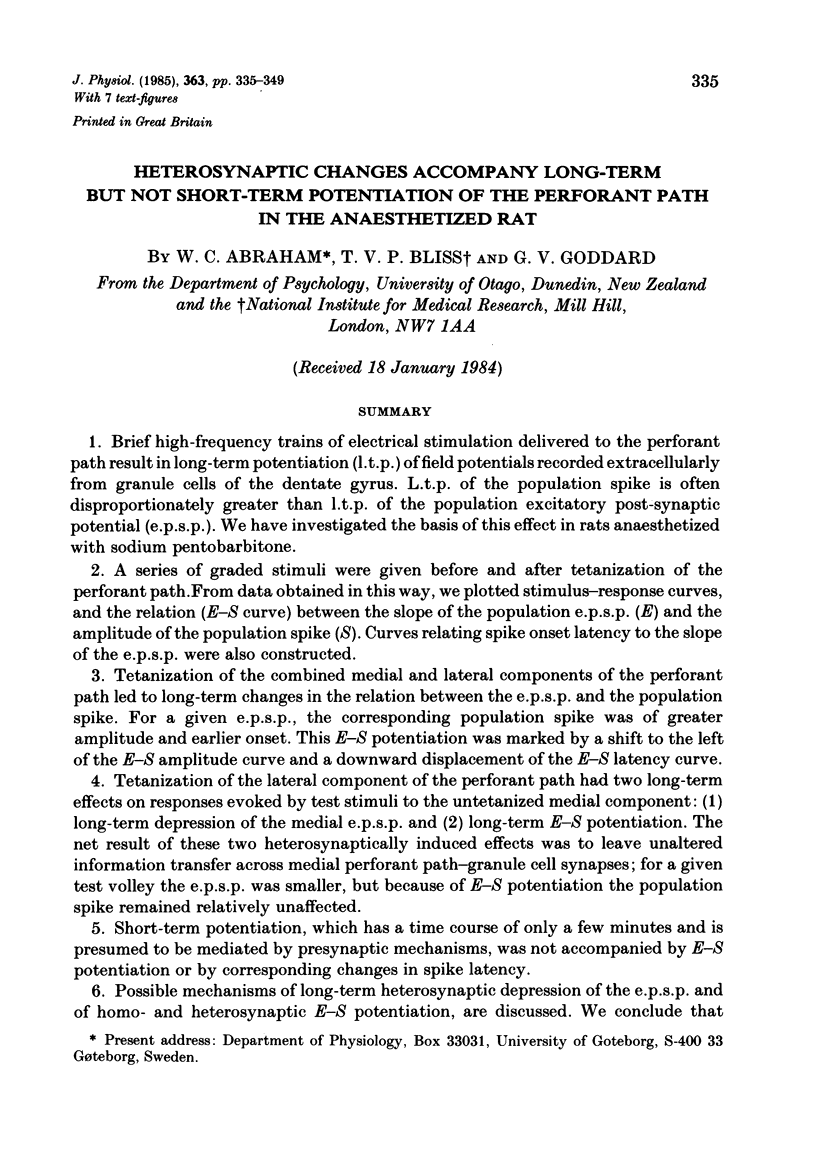
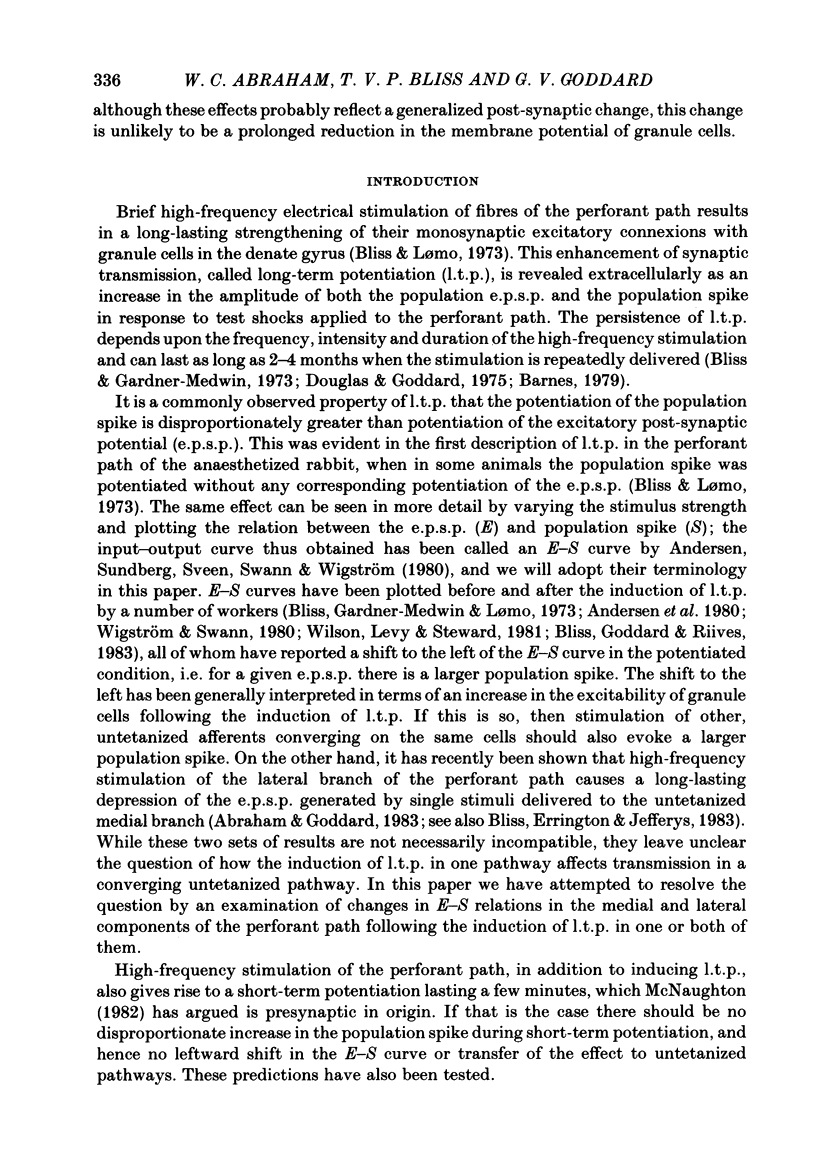
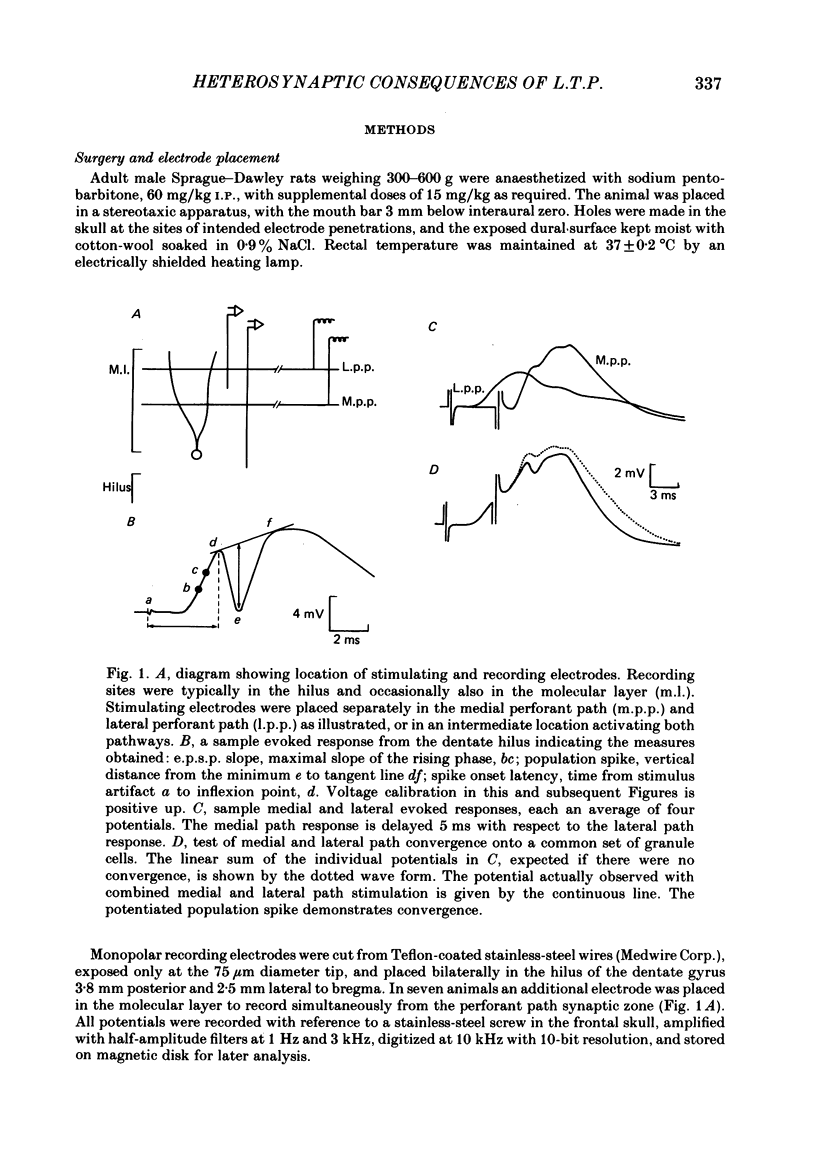
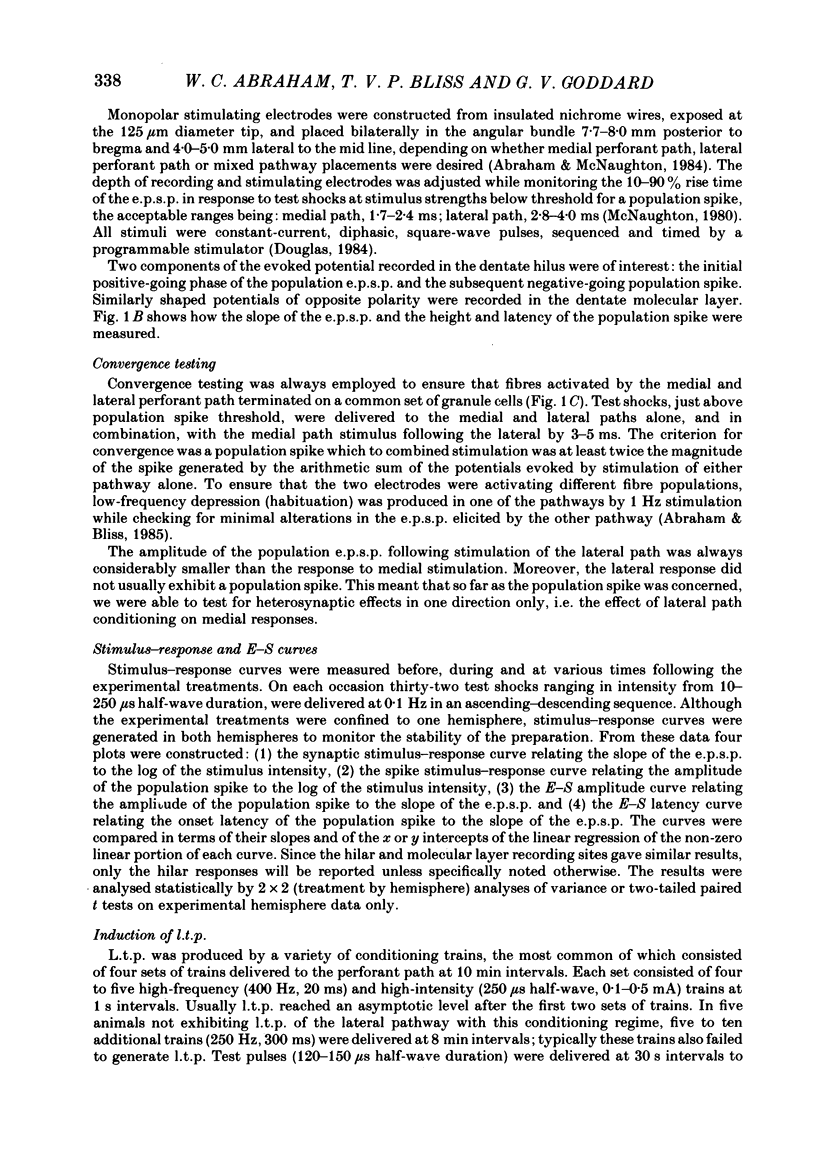
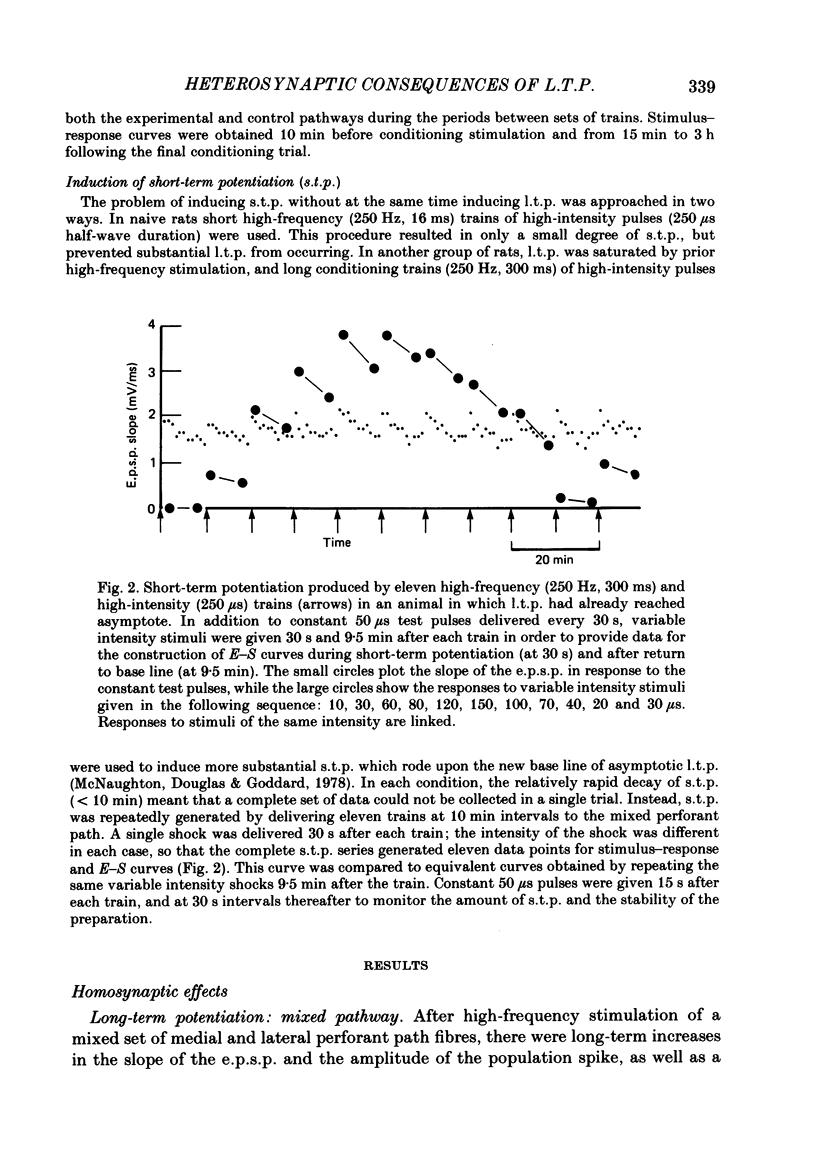
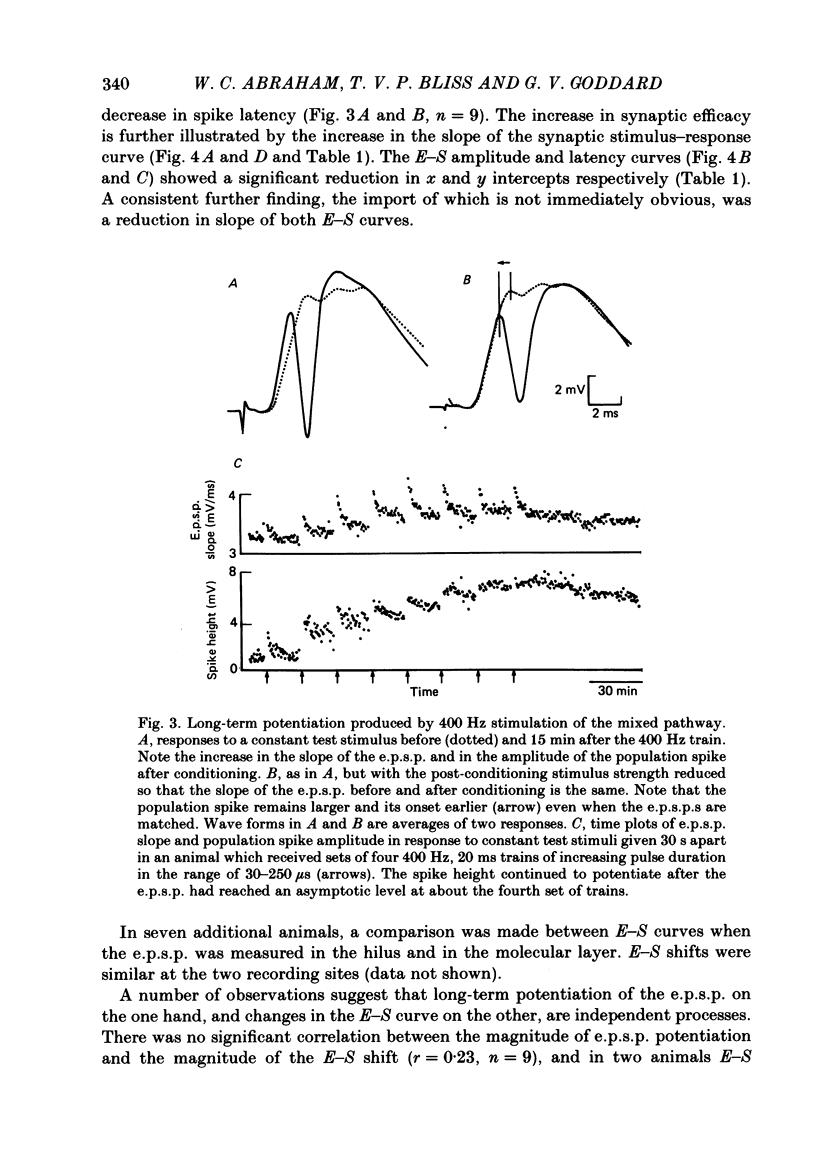
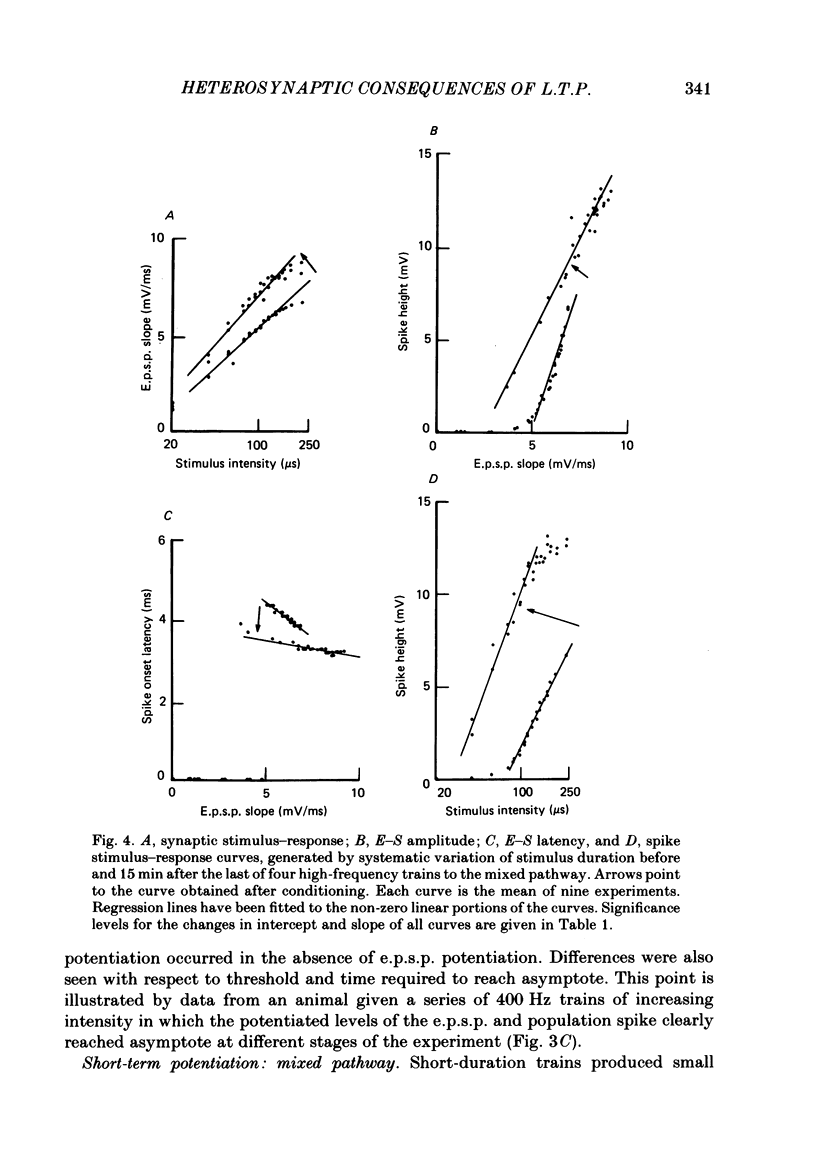
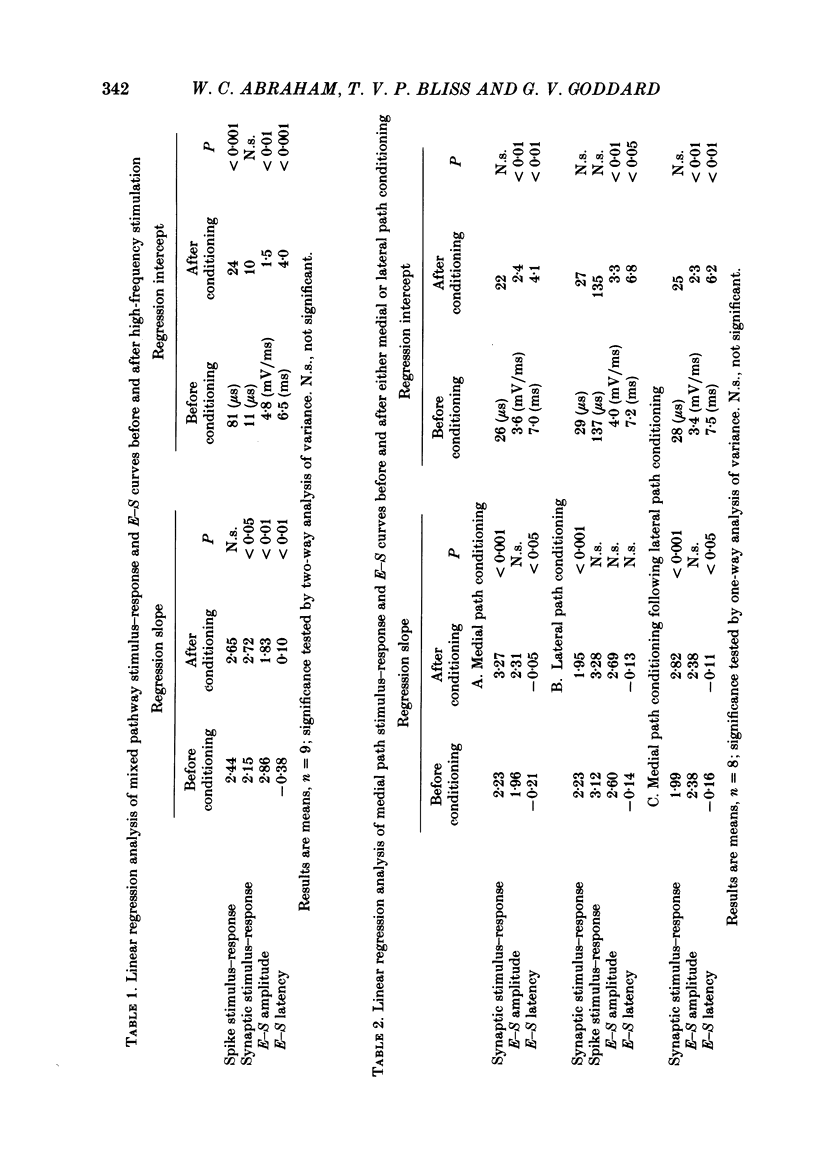
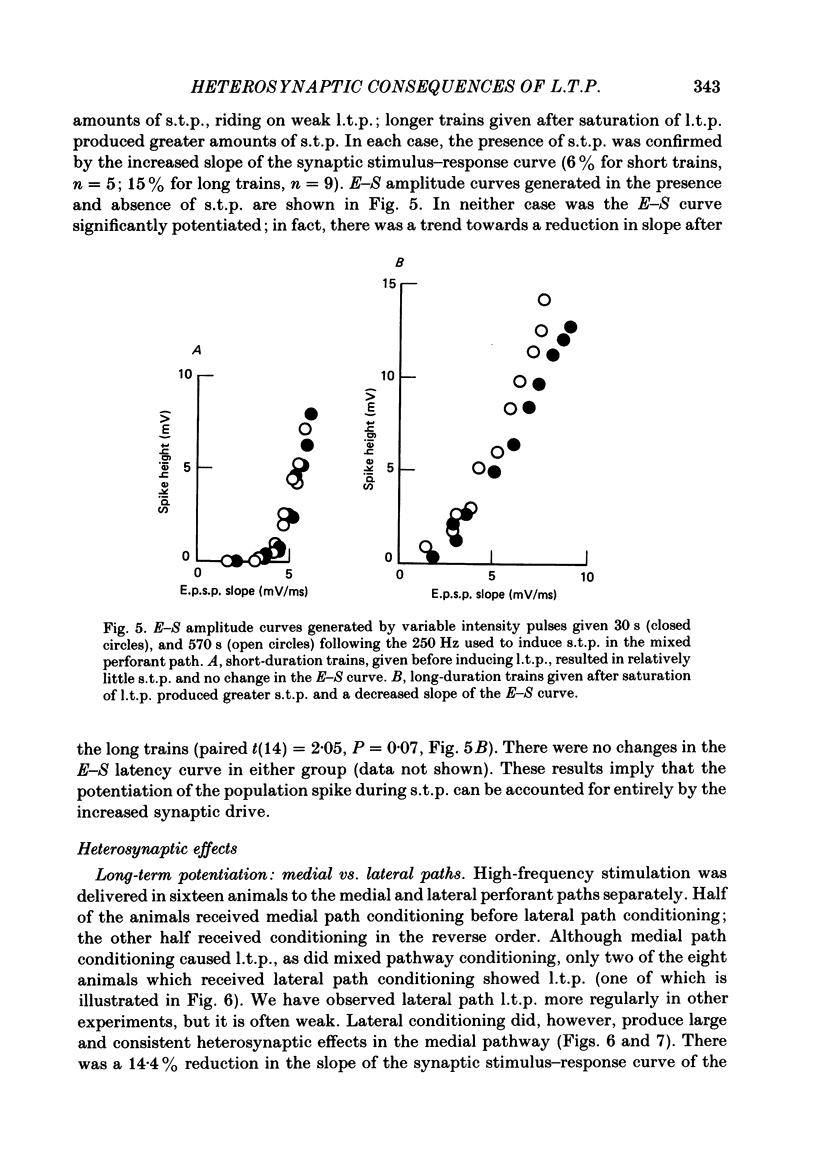
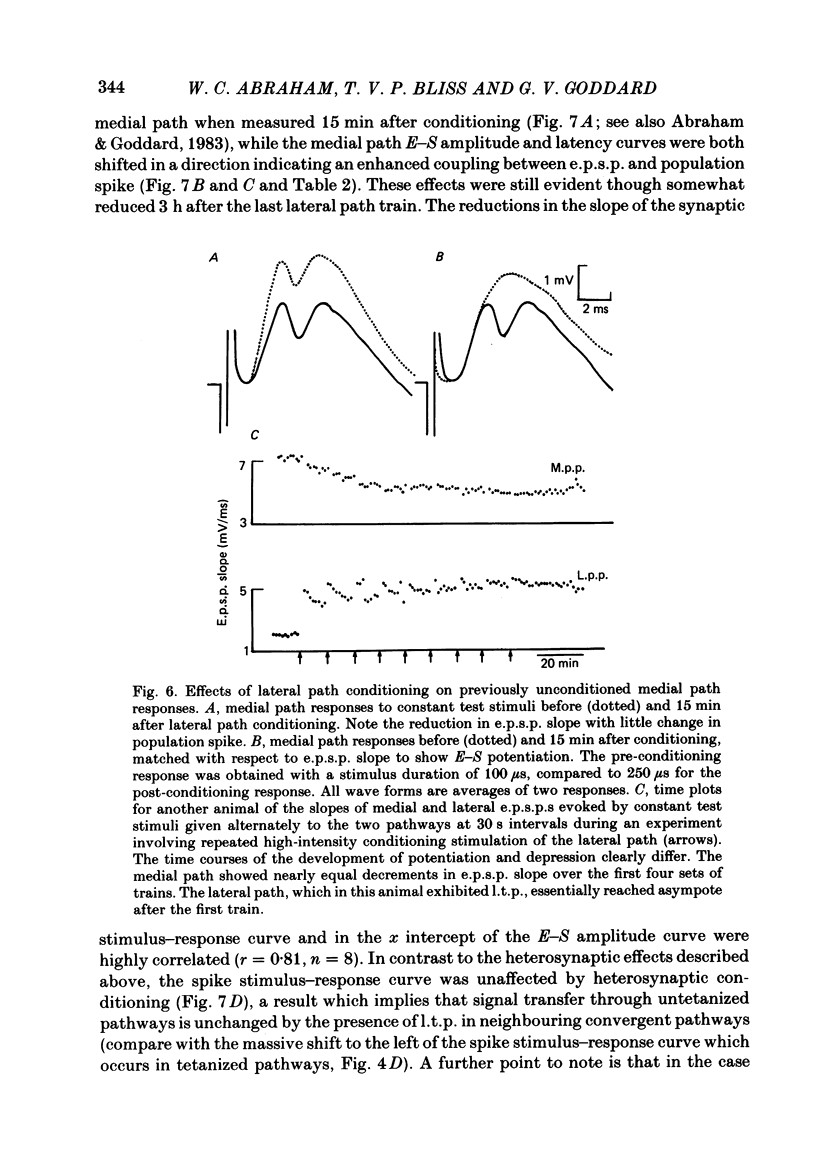
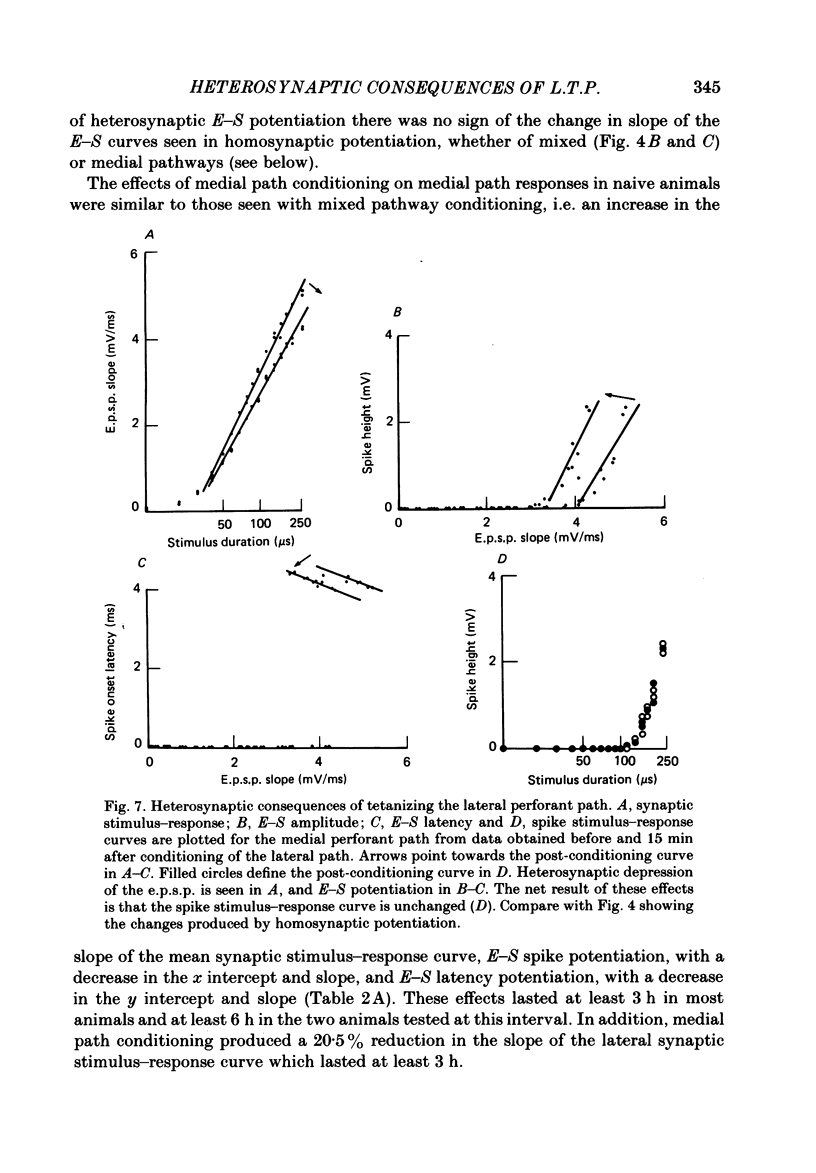
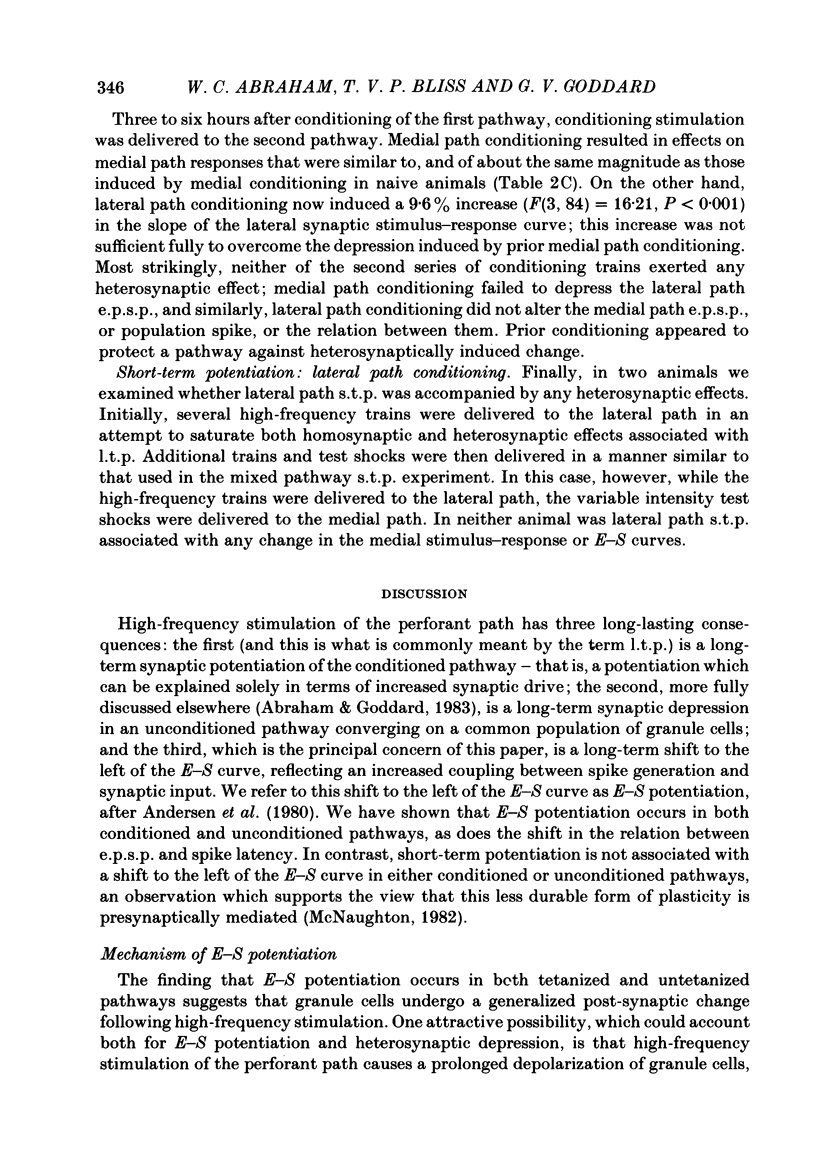
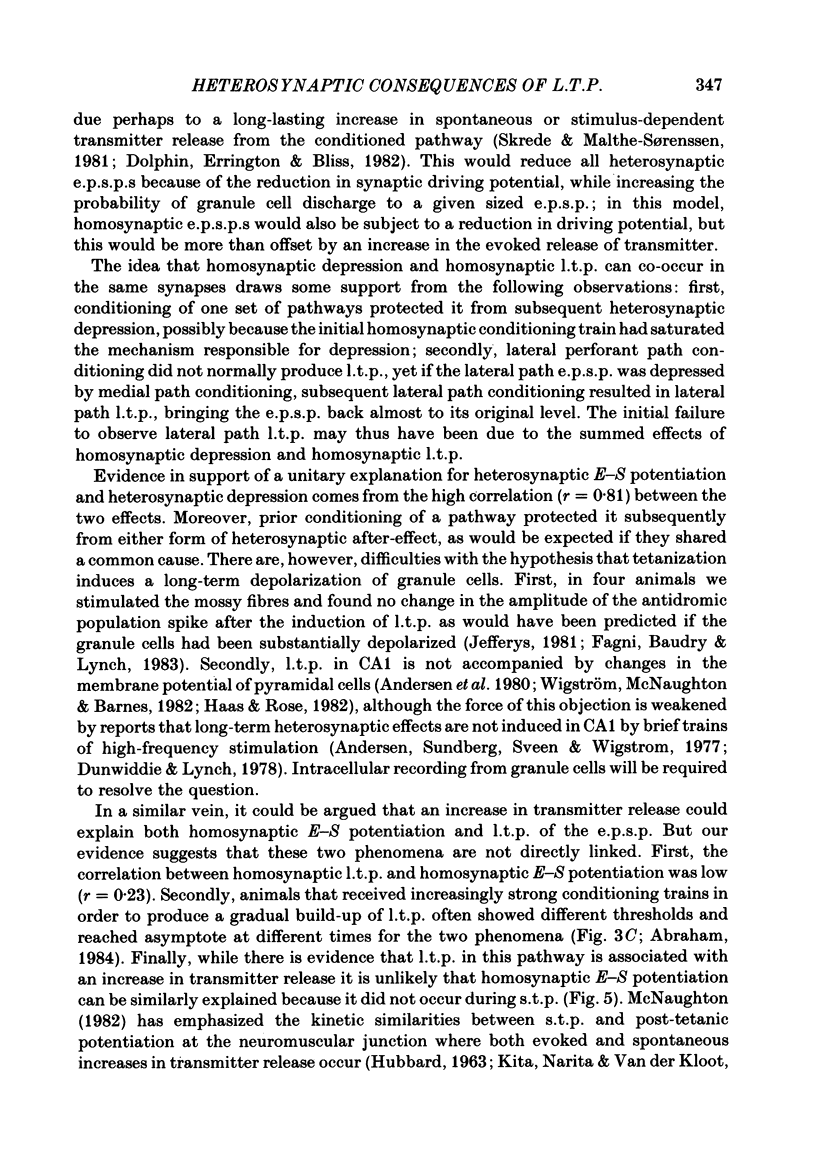
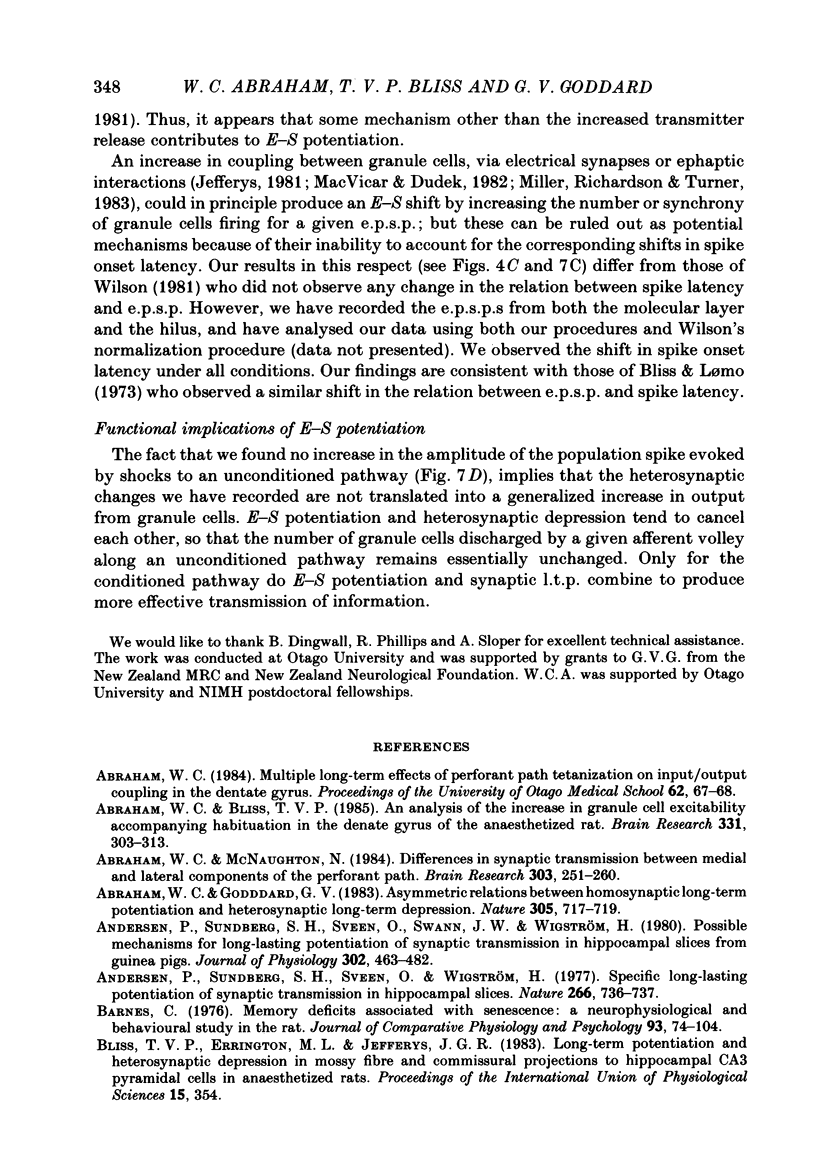
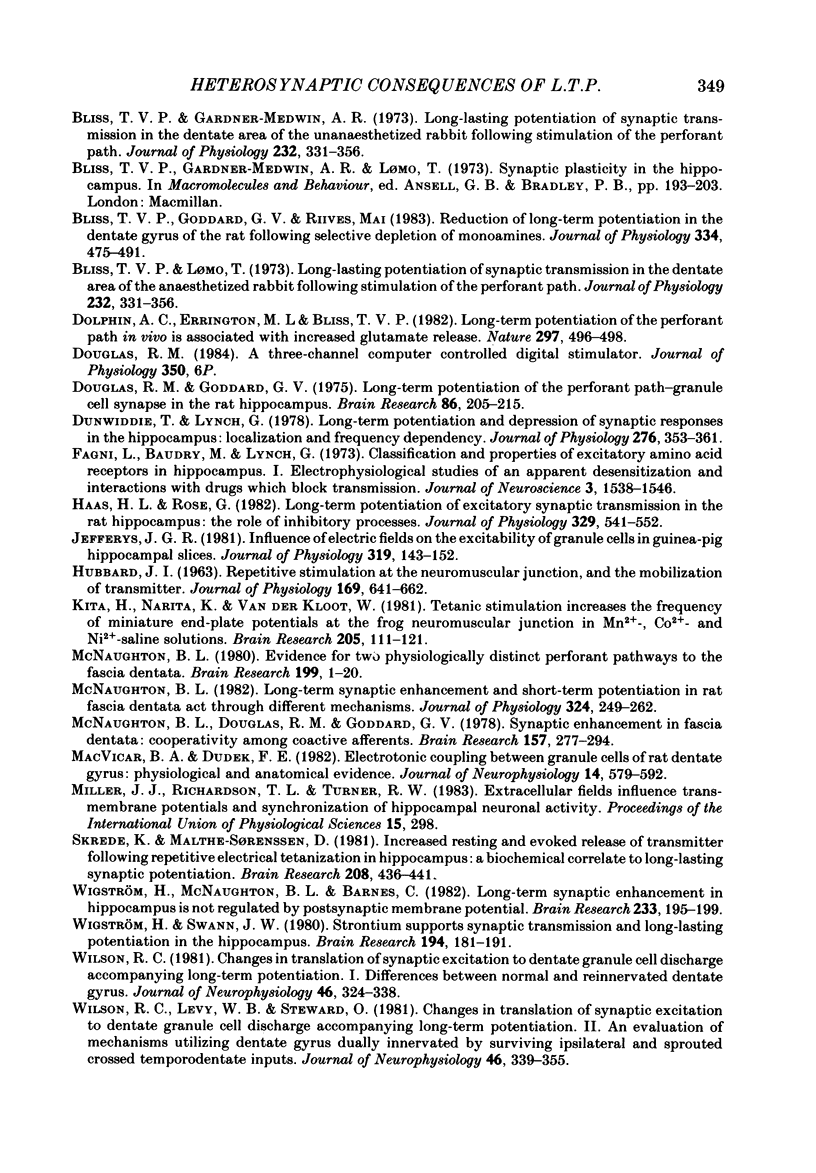
Selected References
These references are in PubMed. This may not be the complete list of references from this article.
- Abraham W. C., Bliss T. V. An analysis of the increase in granule cell excitability accompanying habituation in the dentate gyrus of the anesthetized rat. Brain Res. 1985 Apr 8;331(2):303–313. doi: 10.1016/0006-8993(85)91556-2. [DOI] [PubMed] [Google Scholar]
- Abraham W. C., Goddard G. V. Asymmetric relationships between homosynaptic long-term potentiation and heterosynaptic long-term depression. Nature. 1983 Oct 20;305(5936):717–719. doi: 10.1038/305717a0. [DOI] [PubMed] [Google Scholar]
- Abraham W. C., McNaughton N. Differences in synaptic transmission between medial and lateral components of the perforant path. Brain Res. 1984 Jun 15;303(2):251–260. doi: 10.1016/0006-8993(84)91211-3. [DOI] [PubMed] [Google Scholar]
- Andersen P., Sundberg S. H., Sveen O., Swann J. W., Wigström H. Possible mechanisms for long-lasting potentiation of synaptic transmission in hippocampal slices from guinea-pigs. J Physiol. 1980 May;302:463–482. doi: 10.1113/jphysiol.1980.sp013256. [DOI] [PMC free article] [PubMed] [Google Scholar]
- Andersen P., Sundberg S. H., Sveen O., Wigström H. Specific long-lasting potentiation of synaptic transmission in hippocampal slices. Nature. 1977 Apr 21;266(5604):736–737. doi: 10.1038/266736a0. [DOI] [PubMed] [Google Scholar]
- Barnes C. A. Memory deficits associated with senescence: a neurophysiological and behavioral study in the rat. J Comp Physiol Psychol. 1979 Feb;93(1):74–104. doi: 10.1037/h0077579. [DOI] [PubMed] [Google Scholar]
- Bliss T. V., Goddard G. V., Riives M. Reduction of long-term potentiation in the dentate gyrus of the rat following selective depletion of monoamines. J Physiol. 1983 Jan;334:475–491. doi: 10.1113/jphysiol.1983.sp014507. [DOI] [PMC free article] [PubMed] [Google Scholar]
- Bliss T. V., Lomo T. Long-lasting potentiation of synaptic transmission in the dentate area of the anaesthetized rabbit following stimulation of the perforant path. J Physiol. 1973 Jul;232(2):331–356. doi: 10.1113/jphysiol.1973.sp010273. [DOI] [PMC free article] [PubMed] [Google Scholar]
- Bliss T. V., Lomo T. Long-lasting potentiation of synaptic transmission in the dentate area of the anaesthetized rabbit following stimulation of the perforant path. J Physiol. 1973 Jul;232(2):331–356. doi: 10.1113/jphysiol.1973.sp010273. [DOI] [PMC free article] [PubMed] [Google Scholar]
- Dolphin A. C., Errington M. L., Bliss T. V. Long-term potentiation of the perforant path in vivo is associated with increased glutamate release. Nature. 1982 Jun 10;297(5866):496–498. doi: 10.1038/297496a0. [DOI] [PubMed] [Google Scholar]
- Douglas R. M., Goddard G. V. Long-term potentiation of the perforant path-granule cell synapse in the rat hippocampus. Brain Res. 1975 Mar 21;86(2):205–215. doi: 10.1016/0006-8993(75)90697-6. [DOI] [PubMed] [Google Scholar]
- Dunwiddie T., Lynch G. Long-term potentiation and depression of synaptic responses in the rat hippocampus: localization and frequency dependency. J Physiol. 1978 Mar;276:353–367. doi: 10.1113/jphysiol.1978.sp012239. [DOI] [PMC free article] [PubMed] [Google Scholar]
- Fagni L., Baudry M., Lynch G. Classification and properties of acidic amino acid receptors in hippocampus. I. Electrophysiological studies of an apparent desensitization and interactions with drugs which block transmission. J Neurosci. 1983 Aug;3(8):1538–1546. doi: 10.1523/JNEUROSCI.03-08-01538.1983. [DOI] [PMC free article] [PubMed] [Google Scholar]
- HUBBARD J. I. REPETITIVE STIMULATION AT THE MAMMALIAN NEUROMUSCULAR JUNCTION, AND THE MOBILIZATION OF TRANSMITTER. J Physiol. 1963 Dec;169:641–662. doi: 10.1113/jphysiol.1963.sp007286. [DOI] [PMC free article] [PubMed] [Google Scholar]
- Haas H. L., Rose G. Long-term potentiation of excitatory synaptic transmission in the rat hippocampus: the role of inhibitory processes. J Physiol. 1982 Aug;329:541–552. doi: 10.1113/jphysiol.1982.sp014318. [DOI] [PMC free article] [PubMed] [Google Scholar]
- Kita H., Narita K., Van der Kloot W. Tetanic stimulation increases the frequency of miniature end-plate potentials at the frog neuromuscular junction in Mn2+-, CO2+-, and Ni2+-saline solutions. Brain Res. 1981 Jan 26;205(1):111–121. doi: 10.1016/0006-8993(81)90723-x. [DOI] [PubMed] [Google Scholar]
- MacVicar B. A., Dudek F. E. Electrotonic coupling between granule cells of rat dentate gyrus: physiological and anatomical evidence. J Neurophysiol. 1982 Apr;47(4):579–592. doi: 10.1152/jn.1982.47.4.579. [DOI] [PubMed] [Google Scholar]
- McNaughton B. L., Douglas R. M., Goddard G. V. Synaptic enhancement in fascia dentata: cooperativity among coactive afferents. Brain Res. 1978 Nov 24;157(2):277–293. doi: 10.1016/0006-8993(78)90030-6. [DOI] [PubMed] [Google Scholar]
- McNaughton B. L. Evidence for two physiologically distinct perforant pathways to the fascia dentata. Brain Res. 1980 Oct 13;199(1):1–19. doi: 10.1016/0006-8993(80)90226-7. [DOI] [PubMed] [Google Scholar]
- McNaughton B. L. Long-term synaptic enhancement and short-term potentiation in rat fascia dentata act through different mechanisms. J Physiol. 1982 Mar;324:249–262. doi: 10.1113/jphysiol.1982.sp014110. [DOI] [PMC free article] [PubMed] [Google Scholar]
- Skrede K. K., Malthe-Sørenssen D. Increased resting and evoked release of transmitter following repetitive electrical tetanization in hippocampus: a biochemical correlate to long-lasting synaptic potentiation. Brain Res. 1981 Mar 16;208(2):436–441. doi: 10.1016/0006-8993(81)90573-4. [DOI] [PubMed] [Google Scholar]
- Wigström H., McNaughton B. L., Barnes C. A. Long-term synaptic enhancement in hippocampus is not regulated by postsynaptic membrane potential. Brain Res. 1982 Feb 4;233(1):195–199. doi: 10.1016/0006-8993(82)90941-6. [DOI] [PubMed] [Google Scholar]
- Wigström H., Swann J. W. Strontium supports synaptic transmission and long-lasting potentiation in the hippocampus. Brain Res. 1980 Jul 21;194(1):181–191. doi: 10.1016/0006-8993(80)91327-x. [DOI] [PubMed] [Google Scholar]
- Wilson R. C. Changes in translation of synaptic excitation to dentate granule cell discharge accompanying long-term potentiation. I. Differences between normal and reinnervated dentate gyrus. J Neurophysiol. 1981 Aug;46(2):324–338. doi: 10.1152/jn.1981.46.2.324. [DOI] [PubMed] [Google Scholar]
- Wilson R. C., Levy W. B., Steward O. Changes in translation of synaptic excitation to dentate granule cell discharge accompanying long-term potentiation. II. An evaluation of mechanisms utilizing dentate gyrus dually innervated by surviving ipsilateral and sprouted crossed temporodentate inputs. J Neurophysiol. 1981 Aug;46(2):339–355. doi: 10.1152/jn.1981.46.2.339. [DOI] [PubMed] [Google Scholar]


